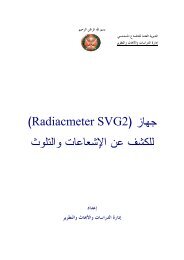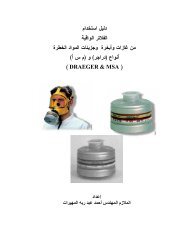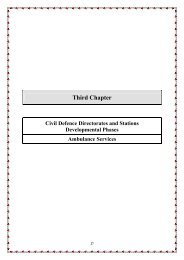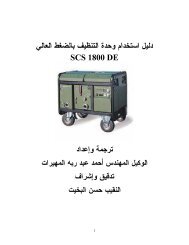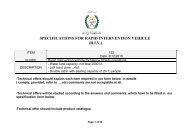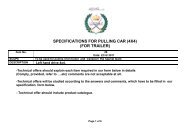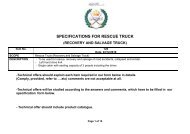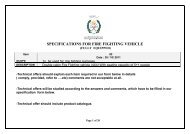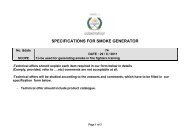chapter 4
chapter 4
chapter 4
- No tags were found...
You also want an ePaper? Increase the reach of your titles
YUMPU automatically turns print PDFs into web optimized ePapers that Google loves.
Fourth Chapter<br />
(Ambulance Service Accidents)<br />
A Comparison of ambulance services accidents during<br />
(2009-2010) in terms of governorates<br />
Ambulance service accidents during 2010 in the<br />
governorates in terms of months<br />
Analysis of ambulance services accidents categories<br />
during (2010)<br />
Comparison of ambulance services accidents categories<br />
during (2009-2010)<br />
Analysis of ambulance services accidents causes during<br />
(2010)<br />
Comparison of ambulance services accidents causes<br />
during (2009-2010)<br />
Ambulance services accidents distribution during (2010)<br />
in terms of occurrence time<br />
The casualties of ambulance services accidents in terms<br />
of age categories<br />
The casualties of ambulance services accidents in terms<br />
of the injury degree (moderate, medium and sever)
Health is a gift from Allah but on the other hand civilization has its tax which Man should pay<br />
on the expense of his health. With this cultural development which human mind reached in the<br />
industrial field, Man became subject to some of those complicated technical machines risks which<br />
had been created either for destruction like weapons or what came as a result of using luxury means<br />
like traffic injuries or the injuries of using manufacturing machines or heating means at homes …<br />
etc.<br />
Ambulance services became a necessity for nations life, and this is because Man became more<br />
and more vulnerable to different kinds of accidents and serious injuries which threaten his life as a<br />
result of machines' and equipments variation and technology development beside the great<br />
dependence on technology products in daily life, at home, school, stores and manufactories … etc.<br />
We can see and hear on televisions the horrible traffic incidents, planes crash, trains impact and the<br />
awful natural disasters and what may come as a result of them e.g. causalities, serious injuries or<br />
mental and physical disabilities, so in order to encounter those results doctors and scientists felt that<br />
it is a part of their duty to find the best ways and means to minimize risks and reduce incidents and<br />
saving lives through providing immediate help for them or helping them to reach doctors or<br />
hospitals as fast as possible, accordingly, the general directorate of Civil Defence began with<br />
spreading health awareness in term of serving first aid for society categories (schools, institutions,<br />
universities students, public and private sectors' employees and house keepers … etc). Through<br />
holding courses, presenting lectures and conducting seminars in order to protect citizens' lives.<br />
In addition to that, the General directorate didn’t save efforts in using rescue latest<br />
technologies and developed means in order to rescue injuries and rescue them professionally.<br />
Therefore, the directorate prepared ambulance vehicles with modern equipments and devices in<br />
addition to qualifying its staff by holding primary and advanced local and international first aid and<br />
paramedic courses. First aid process includes rendering initial care for casualties or severe sudden<br />
morbidities effectively in order to avoid the injuries or morbidities from getting worse. Emergency<br />
medical technicians should do their best using the available resources to save casualties' lives.<br />
In fact any accident goes through five sequent phases as follows:-<br />
1. Man during work: he might be powerless, absent-minded or not well trained.<br />
2. Risk: which is related to human beings like fatigue or negligence or might be related to<br />
tools and equipments e.g. break or electricity cut.<br />
3. Hazard: risks doesn't cause wounds unless there are hazards; the hazard is here is<br />
dangerous conditions or actions which may cause dangers.<br />
4. Incident: the incident happens when Man is exposed to continuous hazards without<br />
undertaking preventative procedures.<br />
5. First aid: first aid is very important in mitigating accidents' consequences; the type of first<br />
aid procedures rendered for casualties are very decisive in saving their lives and mitigating<br />
the accidents' consequences.<br />
Since human beings are honored creatures, we must exert efforts to protect them from<br />
hazards considering that caution reduces consequences of accidents. Community members have<br />
to contribute in spreading awareness about safety and protection and following the related<br />
instructions and laws passed by the authorized bodies.
A Table includes Ambulance Services Accidents Number Which the Civil Defence<br />
Dealt With in Terms of The Governorates During (2009 and 2010)<br />
The Governorate<br />
The Year<br />
2009 2010<br />
Increase or Decrease rate<br />
(%)<br />
Amman 35353 39637 12.5<br />
Irbid 19417 21245 9.41<br />
Al-Balqa’a 6839 7297 6.7<br />
Karak 14316 15932 11.29<br />
Ma’an 5746 5702 .77-<br />
Al-Zarqa 15029 16190 7.73<br />
Al-Mafraq 4522 4970 9.91<br />
Al-Tafeela 3572 3806 6.55<br />
Madaba 2400 2533 5.54<br />
Jerash 2453 3411 39.05<br />
Ajluon 3290 3931 19.48<br />
Aqaba 4077 4666 14.45<br />
The Total 117004 129320 10.53<br />
• The Civil Defense was notified of (12932) ambulance accidents in (2010), they counted for<br />
(%77.34) of the accidents, whereas there was (177004) ambulance services accidents in<br />
(2009) with an increase of ( %10.53). The rate of increase of these accidents was (%22.3).<br />
• (%30.65) of ambulance services accidents which had been reported during (2010) occurred<br />
in Amman, (%16.43) in Irbid, and (12.32%) in Karak.<br />
• The annual increase average of ambulance services incidents in all governorates for (2008)<br />
compared with (2007) is (%22.3), the highest rate was in Jarash reached (%34.6) followed<br />
by Ma'an, (%32.4) finally in Ajlun, (%27.9).<br />
• The lowest rate of ambulance services accidents was in Tafila; (2093) accidents which<br />
formed (%5.54) of ambulance services accidents total which occurred in the Kingdom<br />
during (2010).
This Diagram Shows The General Track of the Ambulance Accidents Which Occurred<br />
In All Governorates In (2008)<br />
35000<br />
39637<br />
30000<br />
25000<br />
Ambulance Accidents Number<br />
20000<br />
15000<br />
10000<br />
21245<br />
7297<br />
15932<br />
16190<br />
5000<br />
5702<br />
4970<br />
3806<br />
2533<br />
3411<br />
3931<br />
4666<br />
0<br />
Amman<br />
Irbid<br />
Al-balq'a<br />
Karak<br />
Maan<br />
Zarka<br />
Al-mafraq<br />
Al-tafeelah<br />
Madaba<br />
Jerash<br />
Ajlune<br />
Al-aqaba<br />
Governorate
A Table Shows The Distribution of Ambulance Accidents All Over the Kingdom During ( 2010) In Terms of Months<br />
The<br />
Governorate<br />
The Month<br />
Amman<br />
Irbid<br />
Al Balqa<br />
Al Karak<br />
Ma’an<br />
Al-Zarqa’a<br />
Al-Mafraq<br />
Al-Tafeela<br />
Madaba<br />
Jarsh<br />
Ajlune<br />
Aqaba<br />
The Total<br />
Jan. 2851 1614 551 1127 370 1231 325 254 174 218 241 361 9317<br />
Feb. 2851 1415 563 1076 386 1268 375 314 217 246 337 339 9378<br />
Mar. 3246 1877 630 1370 454 1385 358 223 183 253 339 396 10814<br />
Apr. 3122 1820 645 1317 447 1293 386 303 184 268 321 401 10507<br />
May. 3312 1846 661 1452 507 1399 453 328 244 288 341 390 11221<br />
June. 3247 1706 633 1294 491 1351 396 295 196 318 306 395 10628<br />
Jul. 3620 1834 730 1474 545 1468 521 335 199 316 361 414 11817<br />
Aug. 3380 1858 651 1460 521 1496 411 329 218 322 314 395 11835<br />
Sep. 3274 1672 602 1274 527 1360 414 210 220 308 368 430 10759<br />
Oct. 3639 1948 594 1431 533 1302 441 326 227 306 349 398 11494<br />
Nov. 3291 1716 474 1217 456 1198 407 331 221 270 290 358 10229<br />
Dec. 3804 1939 563 1440 465 1439 483 358 250 298 364 389 11792<br />
The Total 39637 21245 7297 15932 5702 16190 4970 3806 2533 3411 3931 4666 129320
• The highest rate of ambulance services accidents was recorded during July, (11817)<br />
accidents and this number formed (%9.3) of ambulance services accidents and then during<br />
July ,(9768) incidents which formed (%9.0).<br />
• The highest rate of ambulance services accidents was recorded in Amman; (39637)<br />
accidents which formed (%30.65) of ambulance services accidents followed by Irbid<br />
(%16.43).<br />
• The monthly rate of the ambulance services accidents is (10777) accidents and the highest<br />
number was recorded during July; (11817) accidents.<br />
• The monthly rate of ambulance services accidents in Amman is (3303) accidents and the<br />
highest rate was recorded during January; (3804)incidents.<br />
• The monthly rate of the ambulance accidents in Irbid is (1770) accidents, its highest rate was<br />
recorded during October; (1948) incidents.<br />
• The monthly rate of the ambulance accidents in Al-Balqa’a is (608) accidents, its highest<br />
rate was recorded during July; (730) accidents.<br />
• The monthly rate of the ambulance accidents in Al-Karak is (1328) accidents, its highest<br />
rate was recorded during July; (1474) accidents.<br />
• The monthly rate of the ambulance accidents in Ma’an is (475) accidents, its highest rate<br />
was recorded during August; (545) accidents.<br />
• The monthly rate of the ambulance accidents in Al-Zraqa’a is (1349) accidents and its<br />
highest rate was recoreded during August (1205) accidents.<br />
Regarding to ambulance incidents and morbidities which The Civil Defence dealt<br />
with all over the Kingdome during (2010) will be summarized in the following table:<br />
Incident type<br />
The<br />
number<br />
% Injury<br />
Fatal /<br />
Casualties<br />
Suffocation 371 0.29 561 8<br />
Faint and coma 18206 14.08 15828 2516<br />
Bleeding 1267 0.98 1235 56<br />
Poisoning 2639 2.04 3083 9<br />
Clots 3022 2.34 3020 13<br />
Burns 407 0.31 428 1<br />
Delivery 4407 3.41 4483 2<br />
Wounds 6554 5.7 7086 23<br />
Fractures 5186 4.01 5450 9<br />
Bruises 7673 5.93 8067 1<br />
Abdominal pain 17060 13.19 17272 1<br />
Amputation 70 0.05 71 -<br />
False notifications 415 0.32 - -<br />
Different cases 5637 4.36 5276 43<br />
Other morbidities 56406 43.62 57148 42<br />
The Total 129320 100 129008 2724
This table shows the type of morbidities which were dealt with during (2010). The type of<br />
ambulance services accidents is the type or the kind of the injury or morbidity which the casualty<br />
suffers, or the primary diagnosis by the emergency and medical technician based on the visible<br />
symptoms and the injury type, then the injury is given first aid and transported to the hospital.<br />
(%43.62) of the cases that the ambulance staff dealt with people suffering diabetes,<br />
convulsion, paralysis, pyrexia, high blood pressure, kidney cleansing, and heart diseases … etc.<br />
About (14.08%) of ambulance services accidents are fainting and coma, colic (%13.19), and clots<br />
(2.34%). Those are the most cases which Civil Defence dealt with.<br />
(%5.07) of the cases which the ambulance staff dealt with are wounds. A wound is the<br />
rupture of skin or the other tissues caused by many reasons and may cause bleeding. Wounds are<br />
divided into two types; the open wounds and the closed wounds. The closed wounds cause the<br />
rupture of tissues under the skin without affecting the skin, they are caused by blunt objects. As for<br />
the open wounds, there are the incised wound that are caused by sharp objects, abrasion wounds<br />
caused by skin contact with hard objects, puncture wounds caused by nails, pins and needles,<br />
avulsion wounds caused mostly by objects with irregular edges and wounds caused by gunshots or<br />
explosives which sometimes result in amputating parts of the body. (70) of the ambulance<br />
accidents caused amputations and caused (71) casualties. Amputation accidents are accidents that<br />
may result in amputation of appendages mostly caused by working accidents, sharp devices, traffic<br />
accidents, ... etc.<br />
(5.93 %) of the injuries were bruises caused by many reasons such as traffic accidents, sharp<br />
devices, work injuries, falling accidents, …etc. These accidents may cause avulsions or internal<br />
injuries though they may appear mild for example, when the chest hits the steering wheel in traffic<br />
accidents, the chest injury may be serious and cause death though they may appear mild.<br />
Fractures caused (%4.01) of ambulance services incidents, a fracture is a disconnection in<br />
bone tissue attributed to direct or indirect injuries that are caused by traffic accidents, falling from<br />
high places, work injuries, playing field injuries, fights … etc. They injuries vary from mild to<br />
severe fractures like the spinal column, chest and pelvis fractures.<br />
Poisoning formed (2.04%) of ambulance accidents total. Those incidents caused by: food<br />
poisoning, sting and bite incidents, chemical toxicants like medicines, chemical detergents and<br />
insecticides, alcoholic drinks and drugs. Poison is a substance which can damage body tissues or<br />
cause malfunction of its duties or even death in some cases. Any poisoning object may enter to the<br />
body through many ways e.g. digestive system which is the most common way, breathing system<br />
e.g. poisoning gases inhalation (carbon monoxide for example) and through skin like insecticides<br />
and needles … etc.<br />
Burns injuries constituted (0.31%) of ambulance services incidents total. Burns: are damages<br />
to skin or tissues caused by high or low temperature. Improper use of fires is the main reason for<br />
burns, notice that fire is a gift from Allah if its used properly, otherwise, it will turn into a curse.<br />
There are many reasons for those injuries; electrical shocks, heat or cold strokes, hot liquids<br />
slipping especially when people use heaters to boil or cook. Burns degrees are: first degree, second<br />
degree and third degree, they are also divided to many kinds in term of heat source; e.g. heat burns,<br />
chemical burns, radiation burns, and severe cold burns. Moderate burns may cause serious damage<br />
and deformations in addition to the severe pain, as for the severe ones, they may cause death or<br />
paralysis in addition to other extreme injuries.<br />
(%0.98) of ambulance services accidents were bleeding accidents, although this rate is<br />
comparatively low, bleeding may cause death in some cases especially if the casualty lost large<br />
quantities of blood for long periods of time (10-15 minutes), bleeding severity depends on bleeding
speed . Bleeding is getting blood out of or into body as a result of blood vessel injury or disease.<br />
Vain bleeding is the most dangerous type due to loosing large amounts of blood in a short time<br />
especially in direct injuries like traffic incidents.<br />
We notice that (%92.36) of fatalities were caused by fainting and coma cases while, (%2.06)<br />
were caused by Bleeding, (%1.2) clot cases. Fainting: is a sudden and temporary loss of<br />
consciousness caused by perfusion which has many reasons; e.g. severe fatigue, sugar low sugar<br />
rate, irregular pulse, severe pain and psychological fear caused by sudden sad news, painful sights<br />
… etc.<br />
(%35) of ambulance services accidents were suffocation accidents, this type of accidents is<br />
considered very dangerous because the lack of oxygen reaching to brain for more than five minutes<br />
may cause death. Suffocation might be defined as the lack of oxygen supply to the body as a result<br />
airway blockage caused by swallowing foreign objects or tongue, sore throat, drowning, pressing<br />
the trachea externally as in throttling and hanging, inhaling toxic fire gas emissions like CO, CO 2 ,<br />
HCN, and NH 3 and other toxic gases that may become fatal at certain levels of concentrations.<br />
More over, Playing with cables and plastic ropes may also cause suffocation if a child rolled them<br />
around his nick, and besides he may use his mouth to identify to things so he may swallow many<br />
objects that may obstruct his air way.<br />
(%3.41) of ambulance services accidents were obstructed labours, many of those cases were<br />
handled by emergency medical technicians inside houses or ambulance vehicles during transporting<br />
mothers to hospitals, the numbers of these cases was more than (449) cases.<br />
The number of Ambulance Services Accidents Categories in (2009/2010)<br />
Accident type 2009 2010 Increase or Decrease rate (%)<br />
suffocation 575 371 -35.48<br />
Faint and coma 19574 18206 -6.99<br />
Bleeding 1258 1267 0.72<br />
Poisoning 2245 2639 17.55<br />
Clots 3116 3022 -3.02<br />
Burns 439 407 -7.29<br />
Delivery 4535 4407 -2.82<br />
Wounds 5759 6554 13,80<br />
Fractures 4810 5186 7,72<br />
Bruises 5931 7673 29,37<br />
Abdominal pain 14180 17060 20,31<br />
Others 41507 56406 35,90<br />
False notifications 417 415 -0.48<br />
Amputation 69 70 1.45<br />
Different cases 4621 5637 21.99<br />
Total 109036 129320 18.60
We Can Notice the Following From the Table:-<br />
• The number of most ambulance accidents types increased obviously during (2010)<br />
compared with their number in (2009) and morbidities rate was highest among the<br />
ambulance services accidents; (35.90%), followed by bruises recorded an upraise of<br />
(%29.37).<br />
• The number of other morbidities, bruises and different cases and abdominal pain cases<br />
increased up to (%35.90), (%29.37), (%21.99) and (%20.31) respectively.<br />
• The number of suffocation accidents, burns comma and fainting and decreased up to<br />
(%35.48), (%7.29) and (%6.99) respectively.
A table of Ambulance Incidents For (2008) In Term of Categories<br />
Acccident category<br />
The Governorate<br />
Suffocation<br />
Coma & faint<br />
Bleeding<br />
Poisoning<br />
Clots<br />
Burns<br />
Delivery<br />
Wounds<br />
Fractures<br />
Bruises<br />
Abdominal pain<br />
Morbidities<br />
False notification<br />
Amputation<br />
Different cases<br />
The Total<br />
The Capital 108 6861 271 437 1364 110 670 1765 1773 2984 4356 17362 19 18 1539 39637<br />
Irbid 69 3151 217 351 461 48 491 1189 900 1158 3024 9209 23 2 892 21195<br />
Balqa'a 29 885 52 198 144 35 195 570 346 404 651 3323 30 6 439 7297<br />
Karak 34 1308 164 512 183 66 1067 790 515 727 3659 6459 86 93 403 15982<br />
Ma’an 13 435 138 216 134 23 518 270 216 237 927 2188 63 11 277 5702<br />
Zarqa'a 23 2882 147 216 417 38 343 664 586 856 1689 7348 358 11 935 16190<br />
Mafraq 20 473 64 159 85 22 192 227 197 291 575 2436 28 4 197 4970<br />
Tafila 14 296 39 126 44 10 239 166 108 148 874 1518 64 2 158 3806<br />
Madaba 8 260 23 66 20 8 94 137 111 123 219 1318 7 1 138 2533<br />
Jarash 14 362 29 100 34 18 75 240 140 208 291 1608 47 2 243 3411<br />
Ajloun 25 596 48 125 38 13 44 212 133 224 239 2083 9 1 141 3931<br />
Aqaba 14 697 75 133 98 169 479 324 161 277 556 1554 4 3 275 4666<br />
The Total 371 18206 1267 2245 3022 407 4407 6554 5186 7673 17060 56406 415 70 5637 129320
We Can Notice The Following From The Table:-<br />
• A noticeable upraise in morbidities rate has been recorded all over the Kingdom reaching to<br />
(43.8%) of ambulance services accidents which the Civil Defence dealt with in Amman,<br />
(43.58%) in Irbid and (40.22%) in Karak.<br />
• (24.21%) of the delivery cases that the Civil Defence dealt with in Jordan where in Karak.<br />
• (20.72%) of the false notifications were received in Karak total and (%15.42) were received<br />
in Tafila.<br />
• Most of ambulance accidents types occurred in Amman, where Civil Defence dealt with<br />
(27.03%) of burns, (%45.14) of clots, (26. 93%) of wounds, (%29.11) of suffocation<br />
accidents, (%21.39) of Bleeding accidents, (%16.56) of poisoning cases, (%37.69) of<br />
fainting cases, (%38.89) of bruises injuries and finally (%34.19) of fractures.
This Circular Diagram Shows the Percent of Ambulance Services Accidents and Types During (2010)<br />
suffocation<br />
faint and coma<br />
43.60%; 45%<br />
0.30%; 0%<br />
4.40%; 4% 0.30%; 0%<br />
14.10%; 15% 1%; 1%<br />
13.20%; 13%<br />
5.90%; 6%<br />
2.30%; 2%<br />
2%; 2%<br />
0.30%; 0%<br />
4%; 4%<br />
3.40%; 3%<br />
5.10%; 5%<br />
0.10%; 0%<br />
bleeding<br />
Poisoning<br />
clots<br />
Burns<br />
delivery<br />
Wounds<br />
Amputation<br />
Fractures<br />
Bruises<br />
Abdominal pain<br />
Other morbidities<br />
False notification<br />
Different cases
The Ambulance Services Accidents For (2010) In Terms Of Months<br />
Month<br />
Type<br />
Suffocation<br />
Coma & faint<br />
Bleeding<br />
Poisoning<br />
Clots<br />
Burns<br />
Delivery<br />
Wounds<br />
Fractures<br />
Bruises<br />
Abdominal pain<br />
Morbidities<br />
False Notifications<br />
Amputations<br />
Different Cases<br />
The Total<br />
Jan. 48 1337 76 112 266 26 380 457 404 419 1137 4099 28 7 445 9317<br />
Feb. 53 1337 104 129 232 19 389 378 417 383 1182 4130 24 7 400 9387<br />
Mar. 41 1643 119 190 255 29 397 417 523 502 1318 4640 29 4 470 10814<br />
Apr. 30 1586 93 210 250 30 367 479 545 493 1407 4400 23 3 435 10507<br />
May. 27 1581 94 222 259 40 336 499 575 473 1570 4925 29 8 431 11221<br />
Jun. 21 1641 100 239 244 44 324 560 584 393 1383 4550 39 4 438 10728<br />
Jul. 14 1645 121 384 258 51 318 596 683 491 1545 4998 45 10 566 11817<br />
Aug. 13 1785 94 374 204 45 413 630 647 356 1697 4654 41 6 452 11335<br />
Sep. 19 1415 122 335 241 36 364 523 591 378 1474 4594 33 3 509 10759<br />
Oct. 25 1559 144 210 282 34 336 540 587 456 1589 4945 38 7 509 11494<br />
Nov. 16 1298 82 124 239 28 374 405 496 450 1355 4594 40 5 478 10229<br />
Dec. 64 1479 118 110 292 25 409 394 449 600 1403 5877 46 6 522 11792<br />
The Total 371 18206 1267 2639 3022 407 4407 5759 6554 7673 17060 56406 415 70<br />
563<br />
7<br />
129320
This Table Shows the Number And Type of Ambulance Services Accidents In (2010) In<br />
Terms Of Months, the Table Tells That :<br />
• The monthly rate of morbidities is (4701) and their highest number was recorded in<br />
December (5877) cases, those numbers almost similar to each other during other months.<br />
• The monthly rate of delivery cases is(367) and its highest number was recorded in<br />
December ;(409) cases.<br />
• The monthly rate of poisoning accidents is (220) and its highest number was recorded was<br />
in July; (384) cases. The number of poisoning accidents was high during summer because of<br />
the wrong behaviors that many people commit as not preserving food properly and leaving it<br />
uncovered for long periods of time and the animal and insect stings.<br />
• The monthly rate of clots was (252)cases, their highest number was recorded was in<br />
December ;(292) cases.<br />
• The monthly rate of suffocation accidents is (31), their highest number was recorded in<br />
December; (64) cases. The number of suffocation accidents was high during winter due to<br />
the improper use of heaters.<br />
• The monthly rate of bleeding accidents is (106), their highest number was recorded in<br />
October; (144) cases.<br />
• The monthly rate of false notifications is (35) notification, their highest number was in<br />
December; (46) notifications.
A table Shows the Types of Ambulance Accidents in (2010)<br />
Type Number % Injuries Fatalities<br />
Suffocation<br />
Bleeding<br />
Home gas leakage 38 0.03 94 2<br />
Diesel and kerosene heaters 14 0.01 34 3<br />
Poisoning and throttling gases<br />
of other devices<br />
147 0.11 263 -<br />
Swallowing foreign objects 165 0.13 165 1<br />
Menses 600 0.46 606 -<br />
Nasal hemorrhage 256 0.2 260 -<br />
Food poisoning 446 0.34 844 -<br />
Chemical 855 0.66 872 5<br />
Poisoning<br />
Intoxicants and drugs 36 0.03 36 1<br />
Stings 1094 0.85 1115 -<br />
Snake bites 107 0.08 114 -<br />
Animal bites 90 0.07 94 -<br />
Gun shots 181 0.14 171 27<br />
Burns 80 0.06 87 -<br />
Electrical shock 134 0.10 131 10<br />
Heat stroke 92 0.07 94 -<br />
Hot liquids spill 289 0.22 300 1<br />
Sharp tools 1314 1.02 1335 6<br />
Work injuries 212 .16 228 -<br />
Playground injury 48 0.04 54 -
Falling or slipping from a high location 13441 10.39 13651 23<br />
Fights 2709 2.09 3359 10<br />
Bombs or mines explosions 1 0.001 1 0<br />
Suicides or attempted suicides 69 0.05 60 12<br />
Murders or attempted murders 9 0.01 1 8<br />
Run over 1266 0.98 1343 29<br />
Traffic<br />
accidents<br />
Collision 38 0.03 44 1<br />
Car slipping 43 0. 36 624 3<br />
Other traffic accidents 468 0.38 524 5<br />
Clots 3022 2.34 3020 13<br />
Morbidities 91598 70.83 90198 2523<br />
Deliveries 4409 4.41 4485 2<br />
False notifications 415 0.32 - -<br />
Hot asphalt spill 1 0.001 1 -<br />
Other accidents 5633 4.36 5272 43<br />
The Total 129320 100 129008 2724
We can notice the following from the previous table:-<br />
• The morbidities has constituted (73.17%) of the cases which the ambulance services team<br />
dealt with, their number was high in all governorates.<br />
• (30.65%) of the ambulance accidents happened in Amman.<br />
• Falling from high places accidents constituted (10.39%) of ambulance services accidents,<br />
these accidents are the most common accidents after morbidities. The falling accidents in<br />
Amman and Irbid constituted (33.04%) and (18.79%) respectively.<br />
• Delivery cases constituted (3.41%) of the cases that the ambulance services team dealt with,<br />
(24.20%) of deliveries were in Karak.<br />
12000<br />
10000<br />
9317<br />
9387<br />
10814 10507<br />
11221<br />
10628<br />
11817<br />
11355<br />
10759<br />
11494<br />
10229<br />
11792<br />
ambulance accidents numbers<br />
8000<br />
6000<br />
4000<br />
2000<br />
0<br />
January<br />
February<br />
March<br />
April<br />
May<br />
June<br />
July<br />
August<br />
September<br />
October<br />
November<br />
December<br />
Months<br />
• Food poisoning accidents constituted (0.34%) of the ambulance services accidents some of<br />
which caused dozens of casualties (mass poisoning) which occurred as a result of eating<br />
poisoned foods, poisoning accidents caused (844) casualties; which equals (0.65%) of<br />
casualties that the ambulance services team dealt with.<br />
• Snake bites accidents constituted (0.08%) of the ambulance services accidents. Snake<br />
poisons consist of complicated proteins that affect the nervous system while other types of<br />
poisons affect blood causing bleeding or congelation. Snakes are not all poisonous, in order<br />
to recognize whether the snake is poisonous or not, we have to notice the marks of bites, if
the snake is poisonous it will leave the mark of two canines, otherwise it will leave the mark<br />
of two rows of teeth, besides, the bites poisonous snakes are accompanied with severe pain<br />
after afew minutes. In addition to that, poisoning caused by bites of insects and scorpions<br />
constituted (0.85%) of the ambulance services accidents, some insects' bites may cause<br />
death as a result of nerval shock, there is also a large number of poisonous scorpions<br />
including the yellow, the black, and the brown ones and at the end of their tails there is a<br />
cyst which is full of poison, and a sharp needle which moves in all directions. In Jordan<br />
there are scorpions which are classified among the most dangerous species in the world.<br />
• Poisoning which caused by some animals bites constituted (0.07%) of ambulance services<br />
accidents. Dog bites may cause the hydrophobia if the dog is infected by this disease.<br />
Hydrophobia is a disease which may lead to a severe Brain –infection and ends usually by<br />
death even if the dog was not infected by this disease its bite may lead to different kinds of<br />
diseases e.g. tetanus or moldiness.<br />
• Work accidents constituted (0.16%) of ambulance services accidents. Factories and<br />
workshops workers are exposed to several hazards like natural hazards e.g. heat, cold, and<br />
humidity, chemical hazards, mechanical hazards e.g. movements of keys, machines, saws,<br />
stairs and ladders), electrical hazards, biological hazards e.g. microbes, viruses, and germs<br />
and nuclear hazards produced by different radiations like alpha, beta, and gamma. These<br />
hazards can cause work injuries.<br />
• Sharp tools accidents constituted (1.02%) of ambulance services accidents, these accidents<br />
were caused by misusing these tools. A large number of these accidents were caused by<br />
children; children like playing with sharp tools like: knives, spoons, forks, home<br />
maintenance devices, stationary devices and other devices which are available at home.<br />
Children like playing with what they find, thus, they may harm themselves.<br />
• playgrounds accidents constituted (0.16%) of the ambulance services accidents. Its worth<br />
mentioning that the Civil Defence vehicles exist where there are sport activities in order to<br />
provide injuries with ambulance services; e.g. during (2010), more than (1497) sport<br />
activities were provided with ambulances to provide Civil Defence services during<br />
emergencies, first aid services were provided to more than (54) people during sport<br />
activities. The Civil Defence is giving an important support to athletes through rendering<br />
immediate first aid to them and transporting them to hospitals if required to enable them to<br />
recover within a short time.<br />
• Suffocation accidents constituted (0.28%) of ambulance services accidents. These accidents<br />
caused by such as inhaling poisonous gases emitted from heaters (gas, kerosene, diesel…<br />
etc) or wood stoves or chlorine or ammonia leakage. The Civil Defence dealt with<br />
suffocation (38) accidents caused by gas leakage, many of these accidents could have been<br />
avoided by following simple procedures. Some suffocation accidents are caused by<br />
cleaning wells using water pumps because this process may cause lack of oxygen and<br />
produce a large quantity of suffocating gases such as CO2 .<br />
• Morbidities accounted for (92.62%) of the fatalities that the ambulance teams dealt with<br />
,(1.58%) were caused by other reasons and fatalities of the run over accidents constituted<br />
(1.06%) of the fatalities.<br />
• Gunshots accounted for (0.14%) of the ambulance services accidents; (27) deaths. Though<br />
their number is relatively low rate compared with other accidents, it’s a very important<br />
figure. Many of these accidents happened because of shooting during happy occasions or
misusing weapons. Gunshots can cause severely damage the internal body tissues and<br />
wounds with narrow entrance and wide outlet some times it may not have an entrance or an<br />
out let.<br />
• Electrical shocks are accounted for (0.1%) of the ambulance services accidents, these<br />
accidents caused (10) fatalities and (131) injuries. The electrical shock is a sudden change in<br />
the functions of the muscular and nervous system as a result of having an electrical current<br />
passing through the body , the electrical shock depends on the strength of that electrical<br />
current, its time, its track, its type and its frequency in addition to health status of the body.<br />
The electrical shocks are caused by maintaining appliances without cutting off the<br />
electricity supply from them, , forgetting machines (On) while maintaining them, body<br />
contact with naked wires or electrical cables, having electrical conductors like water,<br />
humidity…etc between the body and the current, not using insulator materials near the<br />
electric sources or not using earthing that transfers high voltage into zero voltage. Electrical<br />
currents can cause severe dangers including rapid death. There are two types of electrical<br />
currents; the direct current and the alternating current. The alternating current is the most<br />
dangerous. Currents usually goes through the least resistant ways; human blood vessels and<br />
nerves. In this regard, water decreases the skin resistance to electrical currents. Electrical<br />
shocks mostly cause severe burns that cant be seen because they have narrow entrance and<br />
wide outlet and other consequences.<br />
• Suicide or attempted suicide constituted (0.05%) of ambulance services accidents which<br />
caused the death of (12) fatalities.<br />
• Hot liquids slipping accounted for (0.22%) of ambulance services accidents, these accidents<br />
aroused from wrong practices of some citizens who put metal utensils or tea pots on heaters<br />
to cook or to heat water, putting such objects on the heaters may be dangerous because they<br />
may fall and cause burns for people near the heaters.<br />
• Fights accounted for (2.09%) of ambulance accidents, which caused (3359) casualties which<br />
constituted (2.6%) of ambulance services accidents casualties l which is relatively a high<br />
rate with compared to other injuries.
A table Shows The Ambulance Services Accidents Types In ( 2009 / 2010)<br />
Type 2009 2010<br />
Decrease or Increase rate<br />
(%)<br />
Suffocation (caused by home gas leakage) 57 38 33.33-<br />
Suffocation (caused by kerosene and diesel<br />
heaters)<br />
9 14 55.55<br />
Suffocation (poisoning gases from other<br />
devices)<br />
234 147 37.18-<br />
Swallowing foreign objects 106 165 55.66<br />
Menses 267 600 124.71<br />
Nasal hemorrhage Bleeding 216 256 18.52<br />
Food poisoning 373 446 19.57<br />
Chemical poisoning 853 855 .23<br />
Intoxication and drugs 54 36 33.33-<br />
Stings 684 1094 33.25<br />
Snack bites 109 107 1.83-<br />
Animal bites 60 90 50<br />
Gun shots 195 181 7.18-<br />
Burns 80 80 -<br />
Electrical shock 127 134 5.51<br />
Heat stroke 76 92 21.05<br />
Sharp tools 1150 1314 14.26<br />
Work injury 340 212 37.65-<br />
Playing ground injuries 60 48 20-<br />
Falling from high places or slipping 12191 13441 10.25<br />
Fights 2281 2709 18.76<br />
Bombs or mines explosion 4 1 .75-<br />
Suicide or suicide attempt 105 69 34.29-<br />
Murder or attempted murder 21 9 57.14-<br />
Hot liquids spill 268 289 7.84<br />
Run over 1147 1266 10.37<br />
Collision 32 38 18.75<br />
Car slipping 35 43 22.86<br />
Other traffic accidents 475 468 1.47-<br />
Clots 3276 3022 7.75-<br />
Morbidities 82227 91598 11.4<br />
Delivery 4551 4409 3.12-<br />
False notification 399 415 4.01<br />
Hot asphalt leakage - 1 -<br />
Other types 4802 5633 17.31<br />
The Total 117004 129320 10.53<br />
This table indicates the following:<br />
• The number of bombs and mines explosions, murders, work injuries, inhaling poisonous<br />
gases and suicides or suicide attempts decreased and the rates of decrease were (75%),<br />
(75014%), (37.35%), (37.18%) and (34.29%) respectively.<br />
• The number of menses bleeding, suffocation caused by swallowing foreign objects,<br />
suffocation caused by kerosene and diesel heaters and poisoning caused by animal bites<br />
increased, the rates of increase were (127.71%), (55.66%), (55.55%) and (50%)<br />
respectively.
A Table Shows Ambulance Services Accidents Types for (2010) in Terms Of Governorates<br />
Accident type<br />
Home<br />
gas<br />
leakage<br />
Diesel<br />
and<br />
kerosene<br />
heaters<br />
Suffocation Bleeding Poisoning<br />
Poisoning<br />
and<br />
throttling<br />
gases<br />
from<br />
other<br />
devices<br />
Swallowing<br />
foreign<br />
objects<br />
Gun<br />
shots<br />
Menses<br />
Nasal<br />
hemorrhage<br />
Governorate<br />
The Capital 15 2 64 21 73 113 59 103 209 17 72 4 12 19 26 8 74 289 128 28<br />
Irbid 4 4 24 38 23 91 48 47 121 3 150 16 11 16 4 11 40 279 38 4<br />
Balq'a 1 3 8 18 16 24 8 27 89 2 61 8 14 5 11 5 22 70 4 -<br />
Kerak 2 1 14 17 11 89 38 88 140 - 265 10 12 6 12 12 50 230 1 -<br />
Ma’an 2 - 5 6 9 90 21 39 37 - 126 3 11 1 6 13 16 64 - -<br />
Zarqa 3 1 8 10 15 60 28 49 91 2 52 1 2 13 3 9 28 118 6 4<br />
Mafraq 2 1 3 14 10 24 11 29 48 2 70 3 3 9 3 5 14 49 16 5<br />
Tafila 2 - 4 8 1 23 6 13 20 - 77 9 14 2 3 1 7 31 - -<br />
Madaba 1 1 1 4 7 9 6 8 14 3 41 0 2 1 - 4 7 41 3 -<br />
Jarash 1 1 2 10 5 8 7 7 30 2 51 1 8 2 7 7 10 47 4 2<br />
Ajloun 2 - 10 13 4 18 13 18 35 1 58 6 7 5 5 5 7 24 8 2<br />
Aqaba 3 - 4 6 7 51 11 18 21 4 71 3 11 11 - 12 14 72 4 3<br />
Food poisoning<br />
The Total 38 14 147 165 181 600 256 446 855 36 1094 36 107 90 80 92 289 1314 212 48<br />
Chemical<br />
Poisoning<br />
Intoxicants and<br />
drugs<br />
Stinging<br />
Snake bites<br />
Animals bites<br />
Burns<br />
Electrical shock<br />
Heat stroke<br />
Hot liquid spill<br />
Sharp tools<br />
Work injury<br />
Playground injury<br />
We can notice the following from the previous table:-<br />
• The number of morbidities and clots is high all over the Kingdome and constituted (73.17%) of ambulance services incidents .<br />
• About (30.65%) of ambulance services accidents which the Civil Defence dealt with were in Amman.
• Falling accidents constituted (10.39%) of the ambulance services accidents, this type of<br />
accidents is considered the highest after morbidities. (33.04%) of the falling accidents were<br />
dealt with happened in Amman and (18.79%) of them happened in Irbid.<br />
• Delivery cases constituted (3.41%) of the ambulance services accidents, (24.20%) of the<br />
deliveries were recorded in Karak.<br />
The Following Diagram Shows The General Track of The Monthly Ambulance Services<br />
Incidents During 2010<br />
12000<br />
9317<br />
10814<br />
10507<br />
11221<br />
10628<br />
11817<br />
11355<br />
10759<br />
11494<br />
10229<br />
11792<br />
10000<br />
9387<br />
ambulance accidents numbers<br />
8000<br />
6000<br />
4000<br />
2000<br />
0<br />
January<br />
February<br />
March<br />
April<br />
May<br />
June<br />
July<br />
August<br />
September<br />
October<br />
November<br />
December<br />
Months<br />
.
A Table Shows Types of The Ambulance Services Accidents (2010) In Terms of Months<br />
Accident<br />
type<br />
The<br />
month<br />
Home<br />
gas<br />
leakage<br />
Diesel<br />
and<br />
kerosene<br />
heaters<br />
Suffocation Bleeding Poisoning<br />
Poisoning<br />
and<br />
throttling Swallowing Gun<br />
gases foreign shots<br />
from objects<br />
other<br />
devices<br />
Menses<br />
Nasal<br />
hemorrhage<br />
Jan. 11 1 19 16 16 41 19 30 59 2 9 4 8 2 7 - 23 87 18<br />
Feb. 10 5 31 7 8 52 25 22 71 4 18 4 8 6 9 - 12 83 13<br />
Mar. 4 2 11 22 17 44 33 36 75 4 55 7 10 7 9 2 21 101 13<br />
Apr. 2 - 7 21 12 46 22 39 77 2 75 6 6 10 5 7 19 104 13<br />
May. 2 - 7 18 14 35 23 40 86 2 87 10 3 6 17 13 32 113 18<br />
Jun. 0 - 8 12 13 60 17 43 75 2 100 8 12 8 12 12 32 123 29<br />
Jul. 0 - 5 9 20 63 21 69 81 1 202 20 8 8 11 20 37 149 21<br />
Aug. 2 - 3 8 20 48 16 41 85 2 225 13 7 10 16 21 32 127 17<br />
Sep. 1 - 5 10 17 66 18 48 87 5 165 20 10 10 11 7 22 114 27<br />
Oct. - - 10 13 12 72 30 37 55 8 97 9 8 7 18 8 24 130 17<br />
Nov. - 1 4 12 19 35 18 21 45 2 48 4 5 3 9 2 20 84 14<br />
Dec. 6 5 37 17 13 38 14 20 59 2 22 2 5 3 10 - 15 99 12<br />
The<br />
Total<br />
Food poisoning<br />
38 14 147 165 181 600 256 446 855 36 1094 107 90 80 134 92 289 1314 212<br />
Chemical<br />
toxicants<br />
Intoxicants and<br />
drugs<br />
Stings<br />
Snake bites<br />
Animals bites<br />
Burns<br />
Electrical shock<br />
Heat stroke<br />
Hot liquid spill<br />
Sharp tools<br />
Work injury
A Continue to The Table Which Shows Ambulance Accidents Types In (2010) In Terms of Months<br />
Incident category<br />
The month<br />
Bombs or mines<br />
Play ground injuries<br />
Falling or slipping from<br />
high places<br />
Fights<br />
Suicide or suicide<br />
attempts<br />
Murder or attempted<br />
murder<br />
Run over<br />
Collision<br />
Slipping<br />
Other traffic accidents<br />
Clots<br />
Morbidities<br />
Delivery<br />
False notification<br />
Hot asphalt spill<br />
Other causes<br />
The Total<br />
Jan. - 2 942 195 4 - 99 2 3 21 266 6558 380 28 - 454 9317<br />
Feb. 1 4 986 186 6 2 89 3 - 34 232 6643 389 24 - 400 9387<br />
Mar. - 2 1250 172 10 1 100 2 2 44 255 7607 397 29 - 470 10814<br />
Apr. - 11 1209 196 10 1 105 4 4 38 250 7381 367 23 - 435 10507<br />
May. - 7 1262 196 6 - 94 3 2 40 259 8057 336 29 - 413 11221<br />
Jun. - 2 1105 215 4 - 84 79 3 42 244 7555 324 39 - 438 10628<br />
Jul. - 3 1247 286 3 1 126 1 5 52 258 8164 318 45 - 563 11817<br />
Aug. - - 1082 313 6 - 87 5 4 45 204 8010 413 41 - 452 11355<br />
Sep. - 1 1055 270 6 1 114 - 4 37 241 7483 364 33 - 507 10759<br />
-<br />
282<br />
-<br />
Oct.<br />
9 1234 264 6 2 125 5 5 37 8088 336 38 508 11494<br />
9<br />
Nov. - 4 1087 225 1 1 129 4 6 39 239 7255 374 40 1 478 10229<br />
Dec. - 31 982 191 7 - 114 2 5 39 292 8797 411 46 - 524 11792<br />
1<br />
126<br />
302<br />
1<br />
The Total<br />
48 13441 2709 69 9<br />
38 43 468 91598 4409 415 5633 129320<br />
6<br />
2
We can conclude the following facts through the previous table:-<br />
• The monthly rate of morbidities and clot cases is (7634) and (252) orderly, the highest<br />
number of morbidities was in August; (7897).Regarding clots the highest number was<br />
recorded in December; (292).<br />
• The monthly rate of traffic accidents was (151) accidents (in ambulance services accidents<br />
only).<br />
• The monthly rate of food poisoning accidents was (69) and its highest number was in<br />
July;(69) incidents. Chemical poisoning monthly rate was (71) cases, its highest rate was in<br />
August (87) incidents.<br />
• The monthly rate of falling accidents was (1120). The highest number of falling accidents<br />
was in May (1262) accidents.<br />
• There are certain accidents are seasonal; their number increase during certain times such as<br />
suffocation accidents which number increase in winter because of heat strokes, misusing<br />
heaters and stings in the summer. Besides, the monthly rate of heat strokes was (8)<br />
accidents, their highest rate was in August (21) accidents. Moreover, The monthly rate of<br />
stings and bites was (5) and (91) orderly, such accidents are more common during summer<br />
due to the increased number of snakes, scorpions, insects and rodents.<br />
• The monthly rate of delivery cases was (367) cases and its highest number was in August<br />
and reached (413) cases.<br />
• The monthly rate of burns caused by liquids spill accidents was (24) , and their highest<br />
number was in June and (37) accidents.<br />
• The monthly rate of gun shots accidents was (15) accidents and their highest numbers were<br />
recorded in July and August;(20) accidents .<br />
• The monthly rate of accidents caused by sharp tools was (110) accidents and their highest<br />
number was in June; (149)accidents.<br />
• The monthly rate of electrical shocks was (11) accidents and their highest number was<br />
recorded in November; (18) accidents.<br />
• The monthly rate of work injuries incidents was (18) incidents and their highest number was<br />
recorded in June ; (29) accidents.<br />
• The monthly rate of accidents caused by intoxicants and drugs was (3) accidents and their<br />
highest number appeared in October; (8) accidents.<br />
• The monthly rate of fights was (226), and their highest rate was in July which reached (258)<br />
accidents.<br />
• The monthly rate of suicide or attempted suicide was (6) accidents and their number was<br />
recorded in March and April; (10) accidents.
The Following Circle Diagram Shows The Monthly Percent of Ambulance<br />
Incidents Services In Term of Month During 2010<br />
7.90%<br />
9.10%<br />
7.20%<br />
7.30%<br />
8.90%<br />
8.40%<br />
8.30%<br />
8.10%<br />
9.10%<br />
8.20%<br />
8.70%<br />
January<br />
February<br />
March<br />
April<br />
May<br />
June<br />
July<br />
August<br />
September<br />
October<br />
November<br />
December
A table Shows The Distribution of Ambulance Services Incidents In Term of<br />
Occurrence Time All Over The Kingdom<br />
The governorate<br />
Time (A)<br />
% of the<br />
accidents in<br />
the<br />
governorate<br />
Time (B)<br />
% of the<br />
accidents in<br />
the<br />
governorate<br />
(C)<br />
% of all<br />
accidents<br />
Amman 17198 43.39 22439 56.61 39637 30.65<br />
Irbid 8486 39.94 12759 60.06 21245 16.43<br />
Zaraka 6422 39.67 9768 60.33 16190 12.52<br />
Zaraka 6323 39.69 9609 60.31 15932 12.32<br />
Karak 3086 42.29 4211 57.71 7297 5.647<br />
Balq'aa 2387 41.86 3315 58.14 5702 4.41<br />
Ma'an 2256 45.39 2714 54.61 4970 3.84<br />
Aqaba 1657 35.51 3009 64.49 4666 3.61<br />
Màdaba 1772 45.08 2159 54.92 3931 3.04<br />
Ajloun 1346 35.37 2460 64.63 3806 2.94<br />
Tafila 1388 40.69 2023 59.31 3411 2.64<br />
Jarash 1010 39.87 1523 60.13 2533 1.96<br />
The total 53331 41.24 75989 58.76 129320 100<br />
• (A) : Accidents occurred between (0800-1600) hrs.<br />
• (B) : Accidents occurred between (1600-0800) hrs.<br />
• (C) = (A) + (B).<br />
1. Its clear that (58.76%) of the ambulance services accidents which the Civil Defence dealt<br />
with occurred between 1600 p.m.- 0800 a.m. of the following day because these are nonworking<br />
hours for the official medical centers, so during this time there is a need to call<br />
Civil Defence in any emergency case in order to provide injuries with ambulance services<br />
and transport them to hospitals especially at remote regions .<br />
2. The highest rate of ambulance services accidents which occurred during period (B) were in<br />
Al-Tafila and reached (64.63%) followed by Aqaba; (64.49%) then Zarqa; (60.33%).<br />
3. Accidents during period (B) were more than the accidents which happened during period<br />
(A) all over the Kingdome .
The Following Circle Diagram Shows The Percent of Ambulance Services Incidents<br />
In term of Occurrence Time<br />
41.20%<br />
Time A<br />
Time B<br />
58.80%
A table Shows age Categories of Ambulance Services Accidents Casualties (Injuries, Deaths) which the civil defence dealt with during 2010<br />
In terms of the Governorates<br />
Age Category<br />
Less than 16 years 16-30 years 31-50 years More than 50 years Un Known The Total<br />
The Governorate injuries deaths injuries deaths injuries deaths injuries deaths injuries deaths injuries deaths<br />
The Capital 3258 28 12076 47 9953 147 13980 799 83 34 39350 1035<br />
Irbid 2463 19 7905 17 4965 56 6040 346 54 5 21427 443<br />
AL- Balqaa 788 11 2389 17 1950 35 1923 157 39 5 7089 225<br />
AL-Karak 2540 4 7023 5 3479 13 2973 62 57 - 16072 84<br />
Ma'an 798 2 2523 6 1244 14 1143 20 13 1 5721 43<br />
AL-Zarqa 1446 12 4897 22 4226 66 5321 432 51 5 15941 537<br />
AL-Mafraq 536 3 2268 4 1259 19 931 53 20 - 5014 79<br />
AL-Tafilah 621 2 1729 5 780 2 704 25 19 - 3853 34<br />
Madaba 303 2 983 7 544 14 628 56 13 - 2471 79<br />
Jarash 466 3 1274 6 860 9 748 59 9 5 3357 82<br />
Ajloune 566 3 1213 2 902 5 1233 38 13 - 3927 48<br />
Aqaba 576 1 2208 3 1250 10 744 20 8 1 4786 35<br />
Total 14361 90 46488 141 31412 390 36368 2047 379 56 129008 2724
• Its clear that the highest rate of injuries was among the age group (16-40 years); (36.03 %).<br />
The older age group ( more than 50 years) came next;(28.19 %). On the other hand, the<br />
highest rate of fatalities were among the age group (more than 50 years); (57.15 %) of the<br />
fatalities, the age group (31-50 years) came next; (14.32 %) of the fatalities.<br />
The following diagram shows the general track of ambulance accidents casualties and<br />
fatalities in term of age category for 2010<br />
8000<br />
14361<br />
46488<br />
31412<br />
36368<br />
7000<br />
6000<br />
Injuries<br />
Deaths<br />
injuries and deaths No.<br />
5000<br />
4000<br />
3000<br />
2000<br />
2047<br />
1000<br />
390<br />
379<br />
90<br />
141<br />
56<br />
0<br />
Less than (16)<br />
years old<br />
(16-30) years<br />
old<br />
(31-50) years<br />
old<br />
more than (50)<br />
years old<br />
unknown<br />
Age category
The Injury Degree of The Ambulance Accidents' Casualties In Terms of The<br />
Governorates During (2010)<br />
The<br />
Governorate<br />
Number of<br />
injuries<br />
Injury degree<br />
Mild Moderate Severe<br />
No. of fatalties<br />
Amman 39350 41 39259 50 1035<br />
Irbid 21427 11 21388 28 443<br />
Al-Balqa’a 7089 10 7068 11 225<br />
Al-Karak 16072 - 16072 - 84<br />
Ma'an 5721 2 5714 5 43<br />
Al-Zarqa 15941 24 15908 9 537<br />
Al-Mafrak 5014 6 5000 8 79<br />
Al-Tafila 3853 - 3851 2 34<br />
Madaba 2471 13 2455 3 79<br />
Jarash 3357 1 3353 3 82<br />
Ajloun 3927 - 3910 17 48<br />
Aqaba 4786 113 4666 7 35<br />
Total 129008 221 128688 143 2724<br />
• The previous table indicates that (99.72) of the injuries got moderate injuries, while (0.17<br />
%) of them got mild injuries and (0.11 %) of the m got severe injuries.<br />
• The rates of injuries and casualties in Amman constituted (30.50%) and (38%) of the<br />
injuries and casualties in the Kingdom.<br />
• About (34.97%) of the severe injuries of ambulance services accidents casualties were in<br />
Amman.<br />
• Fatalities of ambulance accidents in Zaraka constituted (19.71 %) of the fatalities in the<br />
Kingdom, which is a high rate compared with the other governorates.



